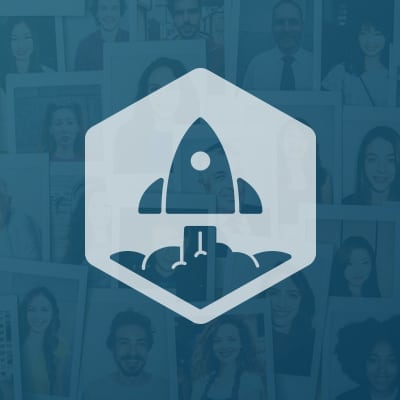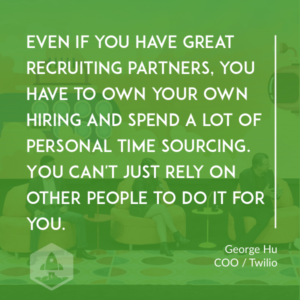 We were very happy to have the Salesforce “Mafia,” consisting of four executives–three who have since moved onto their next ventures–on the Strategy Stage so they could discuss some important lessons learned from being a part of the 19-year-old SaaS powerhouse.
We were very happy to have the Salesforce “Mafia,” consisting of four executives–three who have since moved onto their next ventures–on the Strategy Stage so they could discuss some important lessons learned from being a part of the 19-year-old SaaS powerhouse.
Leyla Seka, EVP of Appexchange/Salesforce, Tod Nielsen, President & CEO of FinancialForce; Cathy Polinsky, CTO at Stitch Fix; and George Hu, COO of Twilio, share the mistakes they made, what they loved about Salesforce’s culture, the importance of establishing priorities and V2MOM, and how they’ve applied what they’ve learned to their new companies.
TRANSCRIPT
Leyla Seka: Hi.
[laughter]
Leyla: It’s going to be an announcement. Maybe it isn’t. I am Leyla Seka. How is it going? I am going to announce myself. I am the Executive Vice President of the AppExchange at Salesforce, and I have the awesome, awesome task today of interviewing three of the most amazing people I’ve ever worked with.
I am going to let them introduce themselves but I will give you the highlight. Tod Nielsen, Cathy Polinsky, George Hu. They all worked at Salesforce. They all did amazing things. They’ve all move on into new things. We are here to talk about that.
First, introduce yourselves, say how long you worked at Salesforce, and say what you’re doing now.
Tod Nielsen: Hi, I am Tod Nielsen. I was at Salesforce for three years. I ran Heroku and the platform. I recently started in January this year, I’m President and CEO of FinancialForce.
Leyla: Woo!
Cathy Polinsky: Hi. I’m Cathy Polinsky. I worked at Salesforce for seven years. Started out leading development teams for the platform, then I went to lead engineering for Emerging Business, which is Work.com. Then, for the last two years, I was leading Search, and really building out our new search platform. Left about four months ago, and I’m now the CTO of Stitch Fix.
Leyla: George.
George Hu: George Hu. I was at Salesforce for 13 years. I started as an intern in 2001, and had a fantastic ride there, did a lot of different things, from products, marketing, platform, applications. Most recently, last three years, I was there, from 2011 to 2014, I was the Chief Operating Officer. Since then, I left, started a company, sold it, and I’m looking forward to what’s next.
Leyla: Jason asked us to do this, because they did a PayPal panel like this, and we thought we’d do something similar with Salesforce. So, I wanted to start out just by asking you guys a question like, Salesforce has a strong culture. What stood out to you, or stands out to you, about the culture? How have you taken something about that with you to the next thing you’ve done. Let’s start with you, Tod.
Tod: The incredible energy and commitment to get something done. There was just an effort of “We’re going to be successful,” and that raw energy is powerful. Sometimes, it wasn’t always even the most focused.
I refer to it as sometimes it was random acts of execution, but they were going to work the hardest to make that happen. Tapping that energy, that drive, and that fire, and bringing it to FinancialForce, is something I’m working on right now.
Leyla: Totally. Cathy, what about you?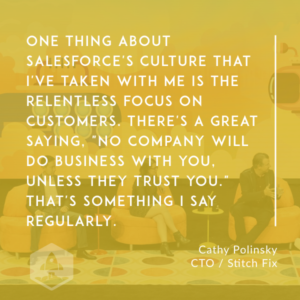
Cathy: For me it was the relentless focus on customers. Salesforce is a customer’s success platform and focusing. I think that there was a great saying that, “No company will do business with you, unless they trust you.”
That’s something I say regularly. It doesn’t matter what business you’re in. it’s just so true for the industry and that’s something I’m going to take with me.
Leyla: What about you, George.
George: A lot of the secret sauce of Salesforce is really the incredible attention and energy put behind alignment and transparency. I remember when Tod joined. We have this process called the V2MOM process, which we use to prioritize everything in the company.
Not only does Salesforce have this rigorous or all these religious focus on prioritization. Every person in the company’s priorities, their goals, objective is shared across the company even. Even the management team’s core V2MOM is actually shared with the entire company. Every employee can see it. There’s not a secret version for the management team.
That focus, that alignment allowed the company to successfully scale. When I joined Salesforce, it was 150 employees. When I left, there was about 16,000. That process of prioritization was consistent all the way through. I think Tod had seen a lot of companies, Microsoft, and was actually shocked at how effective that was at our size.
Tod: It’s incredible. The other things about V2MOM process is if you’ve been at Salesforce awhile, you become very good at drawing priorities and trading things off.
When you were a new person joining, I was like, “What is this language? I don’t understand.” It really took me a few years to appreciate how important it is for providing the transparency and the alignment against the large, large organization.
Leyla: You guys read my mind. My next question is about the V2MOM, which is our planning document at Salesforce. It’s how we run the company. Nicely done. Have you taken any parts of that…
I agree. We are a very transparent company. I just got out of our kickoff. It’s going on right now and we just told the whole company the plan, from Marc’s mouth, all the way down. It’s a very powerful tool.
Are you using maybe not the exact framework, but are you using parts of that in what you’re doing now? If so, how?
George: I’m planning on rolling it out within the FinancialForce and it’s a different process. To an organization that’s not familiar with it, it’s going to take a while to get them to understand the importance of vision, and values, and how to roll it all out. It’s something I plan on adapting for sure.
Leyla: Awesome. What about you, Cathy? It’s Stitch Fix, that’s it. It’s a consumer company, so it’s sort of different.
Cathy: Yeah. Stitch Fix is a personalized styling platform to connect customers using the art and science of data science and human stylist to find clothes for people. It’s a very different business model. I used the V2MOM for my first 90 days. I drafted my own little plan of how I wanted that to work.
The other thing that really resonated with me was just the methods and during this kickoff I remember Mark going up there and saying, “What’s more important? Analytics or IoT? What’s more important? Platform or Service cloud?
As many of you are customers you know all of these things are important and we have to do well for all of them, but, when you’re in an engineering team, you really need to be able to make these trade off decisions when you’re looking at projects, that impact the same teams.”
I’m saying that as Stitch Fix is growing and this hyper growth mode. When we were small it was really easy to know what to work on and only have two or five engineers on something like…
You can’t do that much but now that we have a lot of new initiatives, we launched our men’s line, launching Plus this month, it’s really difficult unless you are very specific about the things that you are doing and the things you are not doing and what’s important.
Leyla: Right. Marc always has this thing that he says that, “If everything is important, nothing’s important,” and I think he actually coined it with George. I think George wrote every V2MOM for the first 16 years we were doing them so that’s pretty interesting.
George, what about you? I mean you did write a lot of Marc’s V2MOM, so talk about that process. How do you write down a strategic document at the CEO level of such a big company and then have it reverberate down in a smart way?
George: I think that the process by which we did it I thought was quite interesting. As a management team, especially early on in the company’s history, the way we did it was that the managing team would get together in a room and we always started the exercise the same way.
It’s actually quite illuminating if you try it, because I do this as a basic management practice. We have everyone in the room, the management team, be there, sit down, have a piece of paper, or your laptop or phone or whatever. We’d say, “OK, we want you to each write down what’s the single most important thing that the company has to do right now to be successful, number one. Then number two, number three.”
You sit there and you actually compare your answers and those become when you synthesize that it becomes the values of the company, those three ideas, when you aggregate them.
It’s really amazing every time you do that exercise you think you’ve been working with these people for months or years on the same projects and you think you’re aligned and suddenly you realize, “Oh my gosh, we are actually thinking totally different things.”
Any time I’ve found myself misaligned, I’ve come back to that process. I remember one year, Dream Force, I did a walk through and it just seemed off. Everything just seemed off, things in the wrong place, parties seemed rough.
I went back to the team and I was like, “OK, I want you all to write down the most important thing for Dream Force this year, and number two and number three.” What was interesting to me was that no one on the marketing team when they wrote it down had sales, closing more deals…
[laughter]
George: …as a top priority. They were focusing on positioning and press coverage and customer excitement and education. But actually, we’d forgotten that we were there to close like a billion dollars in deals. Kind of important, you know, especially if you are a public company with revenue goals.
That process both at a micro and a macro level, I’ve used it actually…What’s interesting is since I’ve left, I think about my own future I wrote a personal V2MOM. A lot of times when you’re moving stuff fast in your own life, you don’t take time to think about “What really matters to me, what do I really want?”
It’s very easy to get…someone calls you and says, “I’ve got this great opportunity, I’ve got this great opportunity.” And it’s hard to synthesize that unless you have clarity of what you want. I’ve actually taken that core practice.
Whether you use that or not, I think having taking time to clarify, prioritize and get alignment is just so critical and I think just an underutilized thing in almost every company I’ve seen.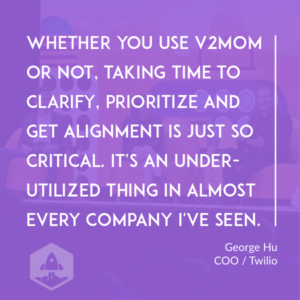
Tod: One other comment on this is, the other side benefit you get is, it lets you have an honest and transparent conversation with your organization on where their priorities are.
A common pitfall that a lot of tech companies make is they tell everybody, “Oh you’re super important, I love you most and you’re great.” Then when they don’t get the budget they need, or don’t get the resources they feel gypped or disappointed and a lot of managers don’t have the ability to communicate clearly what’s going on.
The V2MOM process makes it very clear, “Hey, trust is our number one value. We’re going to invest on that.” If you’re not in the trust space and you’re complaining about your budget over here and product X, you’ll at least understand the context of the company and where it’s going to put its priorities.
Leyla: Totally. George is my mentor, so I’m much like George and I have a personal V2MOM too.
I wanted to switch to a sort of different topic for a second. Technology is thumping crazy, busy, industry, talent, right? I think we all agree the most important part of any company is the people inside of it. Those are the people that actually make all the things happen.
At Salesforce we have an amazing HR team, amazing HR leader. We recruit amazing people. Look, amazing people. So now you’re off doing new things, how do you think about building your teams? And what things from Salesforce, whether it be recruiting or interviewing or just the process with which we hired and did stuff, that maybe influenced how you’re building or thinking about your teams?
Tod: I joined Salesforce on Heroku. Heroku was this little anomaly in SoMa. Sort of like “We’re not sure what to do it, so you take care of it.” The Heroku employees, the average age was 27. It wasn’t quite in the Salesforce mode, so I learned a lot as far as what their approaches were.
One of the unique things they did with recruiting, is they created this concept of, “We’re not going to hire you until you complete a starter project.” We would literally have an engineer come and work with other engineers over a course of two or three days, on their own time, to build a project.
Test to say “OK, is that the kind of code we want on the team?” And this whole idea of starter projects and really assessing the talents and keeping your bar at the level you want to be, is super, super important. It’s something I really value that at Salesforce.
Leyla: Yeah, that’s cool. Cathy, what about you? I mean, you’re building a giant engineering team in a growing company and engineers are hard talent to find as we all know. How are you thinking about it?
Cathy: I would say some of the capabilities or characteristics of people from Salesforce are relentlessly customer focused. Very execution and delivery focused and also partnership focused.
People who can collaborate across their organization and then cross management. The thing I think really resonated with me, is managers who really care about their people. You see that directly from Mark and the stories is that he has and it filters all throughout the organization.
I think that’s what attracted me to the culture at Stitch Fix as well. We have a motto, kind, bright and goal oriented. I think that some of the same capabilities and characteristics I see there as well as at Salesforce.
Those are things that we really try to hire for. Want people who are really focused on goals and delivery, but very focused on customers and working collaboratively across the organization.
Leyla: That’s awesome. George is very modest. He actually left Salesforce. Started a startup and sold it to Twitter, which he doesn’t talk about. But you built a team there and you were the CEO of Salesforce for many years. You were my boss for I don’t know how many, a lot.
How did you think about approaching a team when you left Salesforce and moved into that new environment?
George: Well, you know, when you’re in a larger company, when I left Salesforce it was 16,000 people, right? You start to build support staff. You have a recruiting partner. One of my great recruiting partners, who’s currently the head of the EDP of HR. People at Salesforce somewhere out there. Cindy Robbins was somewhere out there.
Leyla: She’s here. [laughs]
George: She was my first recruiting partner. Fantastic. I had some great partners there. The one thing I think is just a core idea, is that you have to own your own hiring. I mean, you have to spend a lot of personal time sourcing. You can’t rely on other people to do it for you.
They will help you, but I think you have to own it. I think having that skill from Salesforce served me well back in startup land. Because for those of you who are out there who startups not so sure, you don’t have this issue. You’re doing most or all of your own recruiting, but as you scale, you start to build support team. Having to own that I think is critical.
The second thing I would say is that when I think about the hiring. We all have hiring misses. Things we wish we could take back. For me, the number one lesson I learned at Salesforce was do not hire because of time pressure.
Do not hire because you have to fill a need and your gut tells you, this person is like, you know, when you’re starting to sell yourself about why this person is good enough to do the job.
If you have that feeling, you have to stop, because there’s nothing that’s worse than basically hiring the wrong person then basically spending six months to a year sometimes to clean it up. It’s not good for them. It’s not good for you.
Being patient, aggressive, but also patient. When it’s right, there’s nothing more exciting than when you bring someone on your team that you know is the right fit and you just know it’s going to be a home run. It’s great for the team. Everyone feels it.
A lot of people ask me, “How do I move ahead in my career? How my judging?” One thing I tell them is that most basic way I judged people at Salesforce. It was always like the secret room where you’re at like the vice president promotion meeting and everyone’s like “What happens at the meeting? What’s going on?”
I say you know, for me it’s always very simple. We look at the person and the first thing we do is look at their team and say “Has this person built like A players below them?” It’s one of the basic things I would always…it sounds like a simple thing, but when I do a quarterly organizational review or a like a QBR business review, I have them pull up their org chart.
I’d say to the executive, “OK. Here’s the org chart. Let’s point at each of the people below. Is this an A player, a B player, a C player? Let’s go through the list.” Seems like a very basic thing and you’re hoping, you’re expecting they’re going to say A, A, A. They say “A, B, B, C.” What’s going on? It’s actually very telling.
They’re like “Oh yeah, I guess I got to do something about it.” Understanding that dynamic, I think, is something that people, for whatever reason they don’t focus on as much as trying to get the results. Ultimately, it’s the quality of the team that I think sets people apart for being able to take on more and more responsibility in a company.
Leyla: Totally. Anything to add Tod? No. Alright, so you sort of touched on something I wanted to chat about too George. You were talking about it in the frame of making a hiring mistake, which we’ve all done.
George: I’ve made one I think.
Leyla: [laughs] I was not a hiring mistake. [laughs] So speaking of mistakes, we all make them. Do we learn from them? What’s a mistake you made at Salesforce that helped you change the path of your career. Sort of altered you, it may not have mattered, just changed you a bit, made you better, made you worse, whatever you want to share?
Tod. I’m looking at you, you don’t want to go first. [laughs]
Tod: I don’t want to go first.
Leyla: I’ll go first. I’ll tell you one. I made a mistake at Salesforce once. I got overly aggressive about trying to release too much code into our internal instance of Salesforce and I was doing something. I slowed the server way down and I thought I was going to die, because I thought the system was going to go down.
I learned right there that I should never, ever set release schedules for engineering. I should count on engineers to do that. So there’s my mistake. [laughs] Anyone else? Cathy?
Cathy: Similar. Is that one of my earlier projects, I was so focused on getting something out the door fast, that I wasn’t paying attention and kind of letting the project managers focus on what we were building. Then we kind of missed the market.
We missed like when we released it, the adoption was not very good and it really was an early lesson of like “Hey I actually have to not to just worry about how we’re building it, but what we’re building and making sure we’re building the right solution for the customers.”
Tod: I think my response to that will be a little bit more abstract.
Leyla: There you go, it’s fine.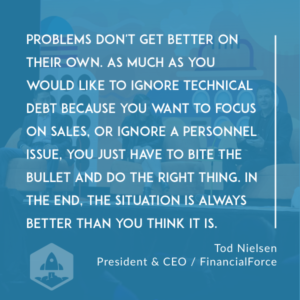
Tod: I’ll say that one of the things I’ve learned in every place I’ve been is that problems don’t get better on their own. As much as you would like to ignore technical debt because you want to focus on sales, or ignore this personnel issue, or whatever, you just have to bite the bullet and do the right thing. At the end it’s always better than you think it is.
When you’re facing the problem you’re like, “I’ll never survive this. This is terrible,” but if you can actually say, “We’re going to fix this problem,” be it technical debt or this personnel issue, or this sales issue, or whatever the problem is, and address it head on and be proactive, you’re going to feel a billion times better, and your company will be better off down the road.
There is many companies I’ve worked at where they didn’t do that, and it sort of was a lingering pain around their neck for a long time.
Leyla: George, anything to add?
Cathy: He doesn’t make mistakes. [laughs]
George: I made a lot of mistakes. I don’t know if I’ll focus on a particular mistake. I will say this, which is that, there is this phrase that we sometimes use, we call them psychosis. Marc would often talk about having these psychosis around self limiting thoughts or beliefs. One of them is around talent actually.
When you’re rising up as an executive in the company, or you’re a young executive, you have this idea of the level of person that would be willing to come work for you. You have a mental of yourself like, “I think I could attract this level of person, but this level of person would never come work for me.”
Having people around me help me break through those things I think was super helpful. I’ll never forget the first time. I had just joined Salesforce a year or two in, I was at manager level, and I remember I was passing someone in the hall and they called me an executive actually.
That was the psychosis I had, that I was at manager level, I didn’t think I was an executive at the company. Maybe I was, maybe I wasn’t. When this person called me an executive, suddenly my self image, my self belief changed. I was like, “Oh yeah,” and the way you carry yourself, and the kind of decisions you make interestingly enough can be different just when you look at the world differently.
I think that plays out in a lot of business decisions too. You think about how your products are structured or your go to market, you get a psychosis around, oh well, of course we’re going to have 20 products because we have these 20 product teams. We branded them all and we marketed them all, then you realize, well actually the customers don’t care about these 17, they only care about these three.
Just reorganizing your mind over and over again, and looking at yourself objectively and saying, “Where am I mentally blocked, because I have a belief that is limiting me?” is something that’s hard to do. That’s why you need mentors and people who can look outside you and tell you what you’ve done wrong.
I lot of my mistakes, frankly, just come from not executing to the capability that I really could do because I just blocked myself.
Leyla: They wrote an article about this about me, because I was very blocked too. You unblocked me, and it was a little hard to hear maybe, but it was the best advice anyone ever gave me in my life. [laughs] It changed my whole career.
There are a lot of really successful people that have come out of Salesforce. You three, so many others, it’s hard to count. Why? What is it about Salesforce that churns out these people that go on to crush it and do all these amazing things beyond? What do you guys think? We sort of talked about it, but is there something other? A little secrete saucy thing that you think really breeds this type of human?
Cathy: I think some of the things I talked about. It’s really people who are focused on results, who are focusing on customers, but are just nice people. I started saying this, is that Marc has a very generous soul.
There have been times in his career where something has happened with an employee at Salesforce, and pretty much every executive at the company knows of some person in the company that’s had a tragedy or a struggle, and he’s personally helped that person. The thing about that is it creates this culture in the company that other people do it too.
If you see someone in your team, in a very smaller scale, where you know that you could do something to help them, people go out of their way to do it. I think that that really sets the tone for who we are, and really inspires a lot of people to go on and do great things elsewhere. Whether it’s in their company or in the world at large.
Tod: You look at when Salesforce started, it was early days of the cloud, so you had to be a disrupter, and believe, and fight. Then when you look at how our industry has progressed in the last number of years, disruption is ripe. Since software as a service is becoming the standard paradigm.
If you’re at Salesforce you’ve learned from the mother ship what software as a service is, and you can be a disrupter, and you can really influence and make an impact on the world. A lot of folks just say, “I want to try to get my own Salesforce and do my own thing.”
George: I’m going to give a weird answer. It’s a little like Guns, Germs and Steel kind of thing, but yes, Salesforce had smart people and a great business model and everything, but in a weird way I attribute a lot of it interestingly enough to the location of the company.
Salesforce was really early, the first company I think that really, one of the first, that built a huge tech business in San Francisco. I remember when I joined Salesforce back in ’01, there wasn’t a ton of options.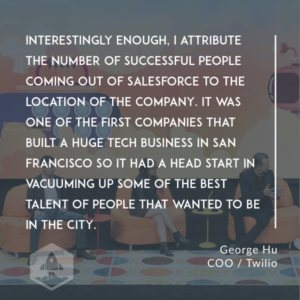
If you wanted to be in San Francisco and I think kind of a free sage where people just wanted to live in cities and work in San Francisco and New York. They’d live in these great cities versus maybe in the suburbs or whatever. I think Salesforce had a head start at vacuuming up some of the best talent of people that wanted to be in San Francisco.
If you look at those people they’ve gone on to do great things. It just gave the company a huge talent advantage in the early days. I don’t think we realized it at the time, but over time I think it really played out. Of course, now every company has a major operation in San Francisco, so it’s a little bit less of an advantage.
Certainly, for the first 7 to 10 years of the company, I think it was an untold hidden advantage in terms of talent.
Leyla: I want you to tell the audience your favorite story from Salesforce. Come on this is so easy there’s so many…
[crosstalk]
Cathy: When we were talking backstage you were mentioning this as like, “What are the stories that you’d always tell your teams or whatnot?” Mine actually is an anti story of these things, where I think about Salesforce a lot, I was there for seven years. My go to response when I’m seeing a problem with scale and growth is like, “How did we do this at Salesforce?”
Or, “At Salesforce we used to do it this way.” One of the early stories that I had was, there was a panel and we were giving advice to new hires, and someone said that, “To be really successful here you have to check your past behind and not say, this is how we did it at Oracle, or BEA, or Microsoft, or any of these other company, because Salesforce is disrupter.
We’re building a brand new business model, and a brand new technology. I don’t care how these other companies did it in the past. We want to know, how should we do it for Salesforce?”
That’s been the story that’s in the back of my head every day. I’m in a company that’s a disrupter, and doing something completely different, and maybe it doesn’t really matter how Salesforce did it.
I should really think about, would it make sense for Stitch Fix? And really come up with solutions there. It just was a really great piece of advice that I try to hold every day.
Tod: I guess my favorite story is probably my Heroku experience. When I started the Heroku team was this wild, this bunch of crazies in SoMa. All of them hated Salesforce, and everybody at Salesforce hated them. I was the broker trying to say, I’m OK. I would start off every meeting by saying, “I’m sorry.” I didn’t matter who I was talking to.
It was like, to the Salesforce people, “I’m sorry that we were entitled and we treated you badly.” The to the Heroku folks I’d say, “I’m sorry Salesforce feels like they bought you, because they did.”
[laughter]
Tod: Then I would sort of bridge the gap. It was a lot of work to bridge these two different groups. I was finally able to do it by having a meeting with them and saying, “You guys, I realize you’re frustrated, but it’s OK to have a rich uncle. Let’s not be the entitled rotten nephew. Let’s be the favorite one. Let’s be the ones he wants to give the keys to the car too and says, this is great.
Over the course of nine months or a year I was able to get them to understand, there is value and there is benefits in synergizing with the mother ship. I left in June, but I actually feel really proud about that work of integration and getting it back into Salesforce and getting that team to feel that now they’re a part of the company and can make a difference.
Leyla: I think that what you did there helped us with lots of acquisitions. You deserve a lot of credit for helping us through that a little bit, thinking about that.
Cathy: Acquisitions are hard.
Leyla: Is your favorite story that I worked for you George? Is that your favorite story?
[crosstalk]
[laughter]
George: It’s really hard I don’t have like one favorite story. I guess I’ll just not answer your question and talk about something else.
Leyla: You’ve been doing that a lot.
George: I’m good at that I think. It’s a little bit answering your question. A lot of times when I fly around the world as the COO I would always get the same question no matter what office I went to. It didn’t matter whether it was in Paris, or Tokyo, or Munich, or in New York, they’d always ask me, “Salesforce is growing so fast. How do we preserve the culture of the company?”
A lot of times it’s interesting because from people that have been hired in the last six months, and they thought now they got the culture and they wanted to make sure it got preserved. It’s interesting because Salesforce is one of the few companies I think out there that doesn’t try to, at least when I was there, didn’t try to document its culture.
It wasn’t one document that said, “Here is all the things we stand for as culture.” I got to thinking about that, and I thought a lot, and I realized the culture is really embodied in the stories that you tell. Cathy alluded to some of the great stories of taking care of employees that were in need.
We had an executive whose daughter got into a huge car accident or something, and the company immediately jumped in and flew her to the best…Just dove right in. Stories like that. When I would fly around the world a lot of the stories I would tell were intended at cultural detox.
What I mean by that is that we’d hire these people from bigger companies, and that’s kind of the way that our industry works, right? You typically look for people that have done it before, and people in bigger companies want somewhat more entrepreneurial experience.
When you’re at Salesforce you’re getting a lot of people from Oracle, and SAP, and Microsoft, and VM, or whatever the company is, and the larger your organization is, the more people generally don’t get rewarded for basically speaking up. [laughs] I remember I once flew to…
I was in Paris and I was talking to our French marketing manager, and I said to him, “Your lead conversion rates just look terrible. What’s happened?” He goes, “Well, right now all of our telesales is in Ireland, in Dublin, and all these people are calling these French customers, and when the French customers see the phone numbers show up they’re actually Irish extensions.”
They speak French, but they don’t look like they’re calling from France, so it looks like a scam, not someone they trust.” I was like, “How hard can it be in the modern age to basically get phone numbers from local phone numbers? It just can’t be that hard.”
I was like, “How long have you know about this issue?” He was like, “Oh, it’s only been like nine months. I’ve got a request in the IT and they tell me they’re going to get to it at some point.”
[laughter]
George: I said, “It’s crazy. You have a relationship with me. You’ve been to headquarters, we know each other. Why didn’t you just let me know and we can get this fixed?” He was, “You’re the COO of the company. I don’t want to bother you…”
That’s all a code for, “I’m afraid if I speak up, that something really bad is going to happen to me.” Nothing bad happened to him. We fixed the problem in three days. Got the phone numbers changed.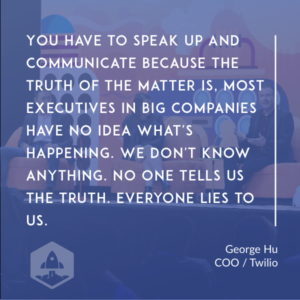
I go around telling stories like that and I’m always going to say, “You have to speak up. you have to communicate,” because truth of the matter is, most executives in big companies have no idea what’s happening.
We all don’t know anything. No one tells us the truth. Everyone lies to us. Your direct report all tells you everything’s perfect. It was, “I’ve got my crap together.” You have to break that. That is really hard to do. That’s why you have to go around just telling story after story after story.
I remember, we bought a company in some other place. I won’t say where it is. We bought a company in another part of the country. I remember once, I went there to visit after the acquisition and I noticed that they had these photos of all these employee bobbleheads.
I was like, “This is great.” “Yeah, we make a custom bobblehead. Our company tradition’s to makes a custom bobblehead for every employee on their one year anniversary.” I’m like, “This is great, but there’s only like 50 bobbleheads here and there’s like 150 employees in the company. What happened?”
“After you bought us, they said there wasn’t any budgets to do bobbleheads, so we stopped it.”
[laughter]
George: I was like, “How much is a bobblehead cost, $20?” I went to the guys. “Oh, yeah. We cut the integration budgets, so things like bobbleheads are a waste of money. We had to cut it.”
[laughter]
George: What the…You have to go around and just tell story after story to break people’s perception of the culture. Otherwise, it’s filtered through 16 levels.
Leyla: I totally agree.
George: Something to remember.
Leyla: Unfortunately, we have to go. I do want to say this, when it comes to storytelling on George’s point, the story of Salesforce is long and wide. The nascence of it, it’s part of how this came to be. Jason was one of our partners and then this all exploded.
I will say the story of Salesforce is richer because the three of you are in it. The nice thing I like about my company because I still work there is I still feel like you work there, even though you’re far away.
I hope you guys got a little bit of a sense of what it’s like to be inside Salesforce from our Salesforce Mafia here. Cocktails are on, ladies and gentlemen all over this building. Go wild. Woohoo. Thank you.

